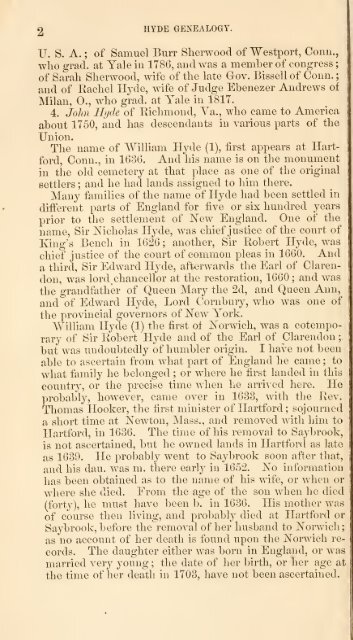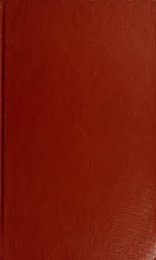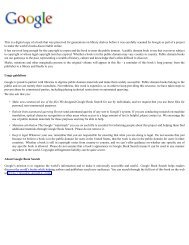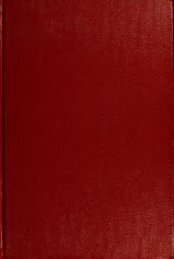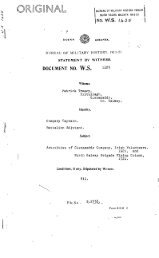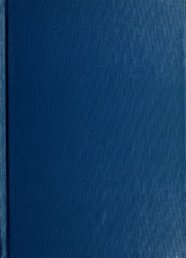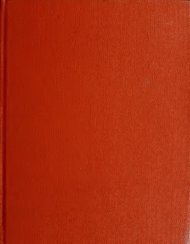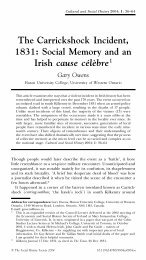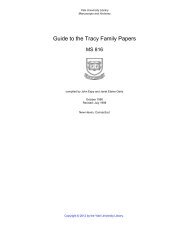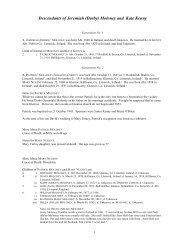- Page 2 and 3: ©ENHAUOGY COl-L-ECTION
- Page 8 and 9: (lf/&-
- Page 10 and 11: Entered according to Act of Congres
- Page 12 and 13: IV PREFACE. in early life removed t
- Page 14 and 15: VI PREFACE. Haller Tracy, the disti
- Page 16 and 17: viii " PREFACE. The compiler has al
- Page 20 and 21: 4 HYDE GENEALOGY. Thomas Lee of Lym
- Page 22 and 23: (3 HYDE GENEALOGY. Samuel Hyde is d
- Page 24 and 25: g HYDE GENEALOGY. July, 1745. He su
- Page 26 and 27: 10 HYDE GENEALOGY. 65. Elizabeth, b
- Page 28 and 29: 12 HYDE GENEALOGY. 90. Esther, b. 1
- Page 30 and 31: 14 HYDE GENEALOGY. gail, b. 6 Aug.,
- Page 32 and 33: 16 i HYDE GENEALOGY. 146. Zina, b.
- Page 34 and 35: X8 HYDE GENEALOGY. '^ so7i-in-law o
- Page 36 and 37: 20 HYDE GENEALOGY. Caleb Hyde (25),
- Page 38 and 39: 22 HYDE GENEALOGY. Abel (98) was a
- Page 40 and 41: 24 HYDE GENEALOGY. daughters. She d
- Page 42 and 43: 26 HYDE GENEALOGY. subsequently gav
- Page 44 and 45: 28 HYDE GENEALOGY. of Korwicli, who
- Page 46 and 47: 30 HYDE GENEALOGY. 291. Mary, b. 22
- Page 48 and 49: 32 + + HYDE GENEALOGY. born at N'ew
- Page 50 and 51: 34 HYDE GENEALOGY. second wife, Mar
- Page 52 and 53: 36 HYDE GENEALOGY. being a stranger
- Page 54 and 55: 38 HYDE GENEALOGY. 36-1. Elijah, b.
- Page 56 and 57: 40 HYDE GENEALOGY. rV. Abner Hyde (
- Page 58 and 59: 42 HYDE GENEALOGY. iu tlie new sett
- Page 60 and 61: 44 HYDE GENEALOGY. Norwicla, was a
- Page 62 and 63: 46 HYDE GENEALOGY. After the death,
- Page 64 and 65: 48 HYDE GENEALOGY. first of Lyme, a
- Page 66 and 67: 50 HYDE GENEALOGY. She m. 23 Dec, 1
- Page 68 and 69:
52 HYDE GENEALOGY. Lee, b. 26 Feb.,
- Page 70 and 71:
54 HYDE GENEALOGY. perseverance. An
- Page 72 and 73:
56 HYDE GENEALOGY. 520. Elizabeth,
- Page 74 and 75:
58 HYDE GENEALOGY. then claimed to
- Page 76 and 77:
60 + HYDE GENEALOGY. of I^orwich, w
- Page 78 and 79:
^2 HYDE GENEALOGY. 604. Barnabas, b
- Page 80 and 81:
64 HYDE GENEALOGY. 621. Another, b.
- Page 82 and 83:
gg HYDE GENEALOGY. wife of Lieut. J
- Page 84 and 85:
(58 HYDE GENEALOGY. gail Denison of
- Page 86 and 87:
70 Their cMldren loere : HYDE GENEA
- Page 88 and 89:
72 HYDE GENEALOGY. (57) of Norwicli
- Page 90 and 91:
74 HYDE GENEALOGY.. Bon of Elijah H
- Page 92 and 93:
76 HYDE GENEALOGY. 770. Wealthy, b.
- Page 94 and 95:
78 Their children were : HYDE GENEA
- Page 96 and 97:
80 HYDE GENEALOGY. third generation
- Page 98 and 99:
82 HYDE GENEALOGY. Trumbiill, of Le
- Page 100 and 101:
g4 t HYDE GENEALOGY. 876. Philo, b.
- Page 102 and 103:
36 HYDE GENEALOGY. 904. Jonathan, b
- Page 104 and 105:
3g HYDE GENEALOGY. Samuel Hyde (4)
- Page 106 and 107:
90 HYDE GENEALOGY. of JSTorwicli, w
- Page 108 and 109:
92 HYDE GENEALOGY. (5) of the third
- Page 110 and 111:
94 + HYDE GENEALOGY. 1036. Charles,
- Page 112 and 113:
9g HYDE GENEALOGY. land of N"orwiel
- Page 114 and 115:
98 - HYDE GENEALOGY. April, 1669, w
- Page 116 and 117:
100 HYDE GENEALOGY. 1111. Lucy L.,
- Page 118 and 119:
102 HYDE GENEALOGY. Hubbard, born a
- Page 120 and 121:
104 H^^^^ GENEALOGY. V. John Tracy
- Page 122 and 123:
[06 BYDE GENEALOGY. + Their childre
- Page 124 and 125:
208 That child was : ' HYDE GENEALO
- Page 126 and 127:
110 + HYDE GENEALOGY. 1243. Thomas,
- Page 128 and 129:
112 HYDE GENEALOGY. 1269. Elizabeth
- Page 130 and 131:
11^ + Their children were : HYDE GE
- Page 132 and 133:
116 HYDE GENEALOGY. 1311. William,
- Page 134 and 135:
118 HYDE GENEALOGY. March, 1749, 5.
- Page 136 and 137:
120 HYDE GENEALOGY. tlie duties of
- Page 138 and 139:
]^22 HYDE GENEALOGY. Y. Ann Hyde (3
- Page 140 and 141:
224 Il^'^E GENEALOGY. . y. Benjamin
- Page 142 and 143:
126 HYDE GENEALOGY. Slie, Abigail(C
- Page 144 and 145:
128 HYDE GENEALOGY. Y. Dr. Theophil
- Page 146 and 147:
130 HYDE GENEALOGY. 1455. Henry, h.
- Page 148 and 149:
132 HYDE GENEALOGY. Conn., 13 May,
- Page 150 and 151:
134 UYBE GENEALOGY. V. Capt. Thomas
- Page 152 and 153:
136 HYDE GENEALOGY. b. 30 April, 17
- Page 154 and 155:
138 HYDE GENEALOGY. (now Franldin),
- Page 156 and 157:
140 I^YDE GENEALOGY. IsTorwicli. Tl
- Page 158 and 159:
242 HYDE GENEALOGY. 1602. James, b.
- Page 160 and 161:
144 HYDE GENEALOGY. 1623. Erastus,
- Page 162 and 163:
146 HYDE GENEALOGY. (now Franklin),
- Page 164 and 165:
][4g HYDE GENEALOGY. Famham, and se
- Page 166 and 167:
150 • HYDE GENEALOGY. 1712. Rodne
- Page 168 and 169:
152 HYDE GENEALOGY. master at Taber
- Page 170 and 171:
154 HYDE GENEALOGY. V. Dice Hyde (4
- Page 172 and 173:
156 HYDE GENEALOGY. She then m. 27
- Page 174 and 175:
158 + + HYDE GENEALOGY. 1807. Abiga
- Page 176 and 177:
160 HYDE GENEALOGY. Elizabeth Lynde
- Page 178 and 179:
262 HYDE GENEALOGY. a farmer, and d
- Page 180 and 181:
IQ^ HYDE GENEALOGY. After the cleat
- Page 182 and 183:
165 HYDE GENEALOGY. third generatio
- Page 184 and 185:
168 + HYDE GENEALOGY. 1921. Theodor
- Page 186 and 187:
170 HYDE GENEALOGY. ter of Richard
- Page 188 and 189:
172 HYDE GENEALOGY. 1971. Mary 2cl,
- Page 190 and 191:
174 HYDE GENEALOGY. and was the thi
- Page 192 and 193:
UQ HYDE GENEALOGY. E'orwich, tlie y
- Page 194 and 195:
178 HYDE GENEALOGY. V. David Jewett
- Page 196 and 197:
180 HYDE GENEALOGY. 2043. Lucy, b.
- Page 198 and 199:
132 HYDE GENEALOGY. 2063. Hannah, b
- Page 200:
284 HYDE GENEALOGY. V. Thomas Grisw
- Page 203 and 204:
HYDE GENEALOGY. 185 1696, m. Martha
- Page 205 and 206:
I + HYDE GENEALOGY. 187 After the d
- Page 207 and 208:
+ I HYDE GENEALOGY. X89 a member of
- Page 209 and 210:
HYDE GENEALOGY. 191 ElizahGtli Marv
- Page 211 and 212:
HYDE GENEALOGY, 293 2210. Nicholas,
- Page 213 and 214:
HYDE GENEALOGY. 195 2237. Mary, b.
- Page 215 and 216:
+ HYDE GENEALOGY. ^97 East Lyme. 3.
- Page 217 and 218:
His cMldren hy her were : HYDE GENE
- Page 219 and 220:
HYDE GENEALOGY. 201 Y. Samuel Post
- Page 221 and 222:
HYDE GENEALOGY. 2347. Elizabeth, b.
- Page 223 and 224:
HYDE GENEALOGY. 205 and Hester Hyde
- Page 225 and 226:
HYDE GENEALOGY. 207 2397. Ebenezer,
- Page 227 and 228:
HYDE GENEALOGY. 209 Y. Abigail Abel
- Page 229 and 230:
HYDE GENEALOGY. 211 V. Anne Abel (5
- Page 231 and 232:
HYDE GENEALOGY. 213 V. Elijah Abel
- Page 233 and 234:
HYDE GENEALOGY. 215 non, third daug
- Page 235 and 236:
HYDE GENEALOGY. 217 Long Island, an
- Page 237 and 238:
HYDE GENEALOGY. 219 of the revoluti
- Page 239 and 240:
HYDE GENEALOGY. 221 2566. Jabez, b.
- Page 241 and 242:
HYDE GENEALOGY. 223 and had a daugh
- Page 243 and 244:
HYDE GENEALOGY. 225 2592. Hannah, b
- Page 245 and 246:
+ HYDE GENEALOGY. 227 She then m. 1
- Page 247 and 248:
HYDE GENEALOGY. 229 (118), was a gr
- Page 249 and 250:
HYDE GENEALOGY. 231 2652. Abigail,
- Page 251 and 252:
Their children were : HYDE GENEALOG
- Page 253 and 254:
HYDE GENEALOGY. 235 Her children hy
- Page 255 and 256:
Her children hy him were : HYDE gen
- Page 257 and 258:
+ HYDE GENEALOGY. 239 2729. Elijah,
- Page 259 and 260:
+ HYDE GENEALOGY. 241 2760. Chcarlo
- Page 261 and 262:
HYDE GENEALOGY. 243 1852, F. J. S.
- Page 263 and 264:
HYDE GENEALOGY. 245 living at Linkl
- Page 265 and 266:
HYDE GENEALOGY. 247 Their children
- Page 267 and 268:
HYDE GENEALOGY. 249 bauon, son of A
- Page 269 and 270:
HYDE GENEALOGY. 251 May, 1837, Henr
- Page 271 and 272:
HYDE GENEALOGY. 253 6. Mary Stark,
- Page 273 and 274:
HYDE GENEALOGY. 25^ 5. Mary Anne, b
- Page 275 and 276:
Their children were : : HYDE GENEAL
- Page 277 and 278:
: HYDE GENEALOGY. 259 3. Bcnry Dwig
- Page 279 and 280:
HYDE GENEALOGY. 261 sin, Joseph Wad
- Page 281 and 282:
Their cMldren were : HYDE GENEALOGY
- Page 283 and 284:
HYDE GENEALOGY. 265 Samuel Selden,
- Page 285 and 286:
HYDE GENEALOGY. 267 Sacket, was a g
- Page 287 and 288:
HYDE GENEALOGY. 269 2. Norman ff.,
- Page 289 and 290:
HYDE GENEALOGY. 271 2915. John Eo-g
- Page 291 and 292:
HYDE GENEALOGY. 273 Jane, b. 28 Mar
- Page 293 and 294:
HYDE GENEALOGY. 275 2934. Cliarles
- Page 295 and 296:
HYDE GENEALOGY. 277 1856, at Belved
- Page 297 and 298:
HYDE GENEALOGY. 279 non, by liis fi
- Page 299 and 300:
HYDE GENEALOGY. 281 Maple Grove, Mi
- Page 301 and 302:
HYDE GENEALOGY. 283 at Shaftsbnry,
- Page 303 and 304:
flYDE GENEALOGY. 285 VI. RtTH Hyde
- Page 305 and 306:
HYDE GENEALOGY. 287 at Martinsburgh
- Page 307 and 308:
: HYDE GENEALOGY. 289 living in 186
- Page 309 and 310:
HYDE GENEALOGY. 291 VI. EoswELL Hun
- Page 311 and 312:
HYDE GENEALOGY. 293 New Haven, Conn
- Page 313 and 314:
HYDE GENEALOGY. 295 Mills and Eliza
- Page 315 and 316:
HYDE GENEALOGY. 297 on, by his seco
- Page 317 and 318:
HYDE GENEALOGY 299 was ordained as
- Page 319 and 320:
HYDE GENEALOGY. 3Q1 The daughter wa
- Page 321 and 322:
: HYDE GENEALOGY. 303 ?>. Mary, b.
- Page 323 and 324:
HYDE GENEALOGY. 305 1. Nannj P., b.
- Page 325 and 326:
HYDE GENEALOGY. 3O7 March, 1856, d.
- Page 327 and 328:
HYDE GENEALOGY. 309 7. Frances Ahig
- Page 329 and 330:
HYDE GENEALOGY. ^^^ Walter and Judi
- Page 331 and 332:
HYDE GENEALOGY. 313 5. Elka, b. 7 N
- Page 333 and 334:
HYDE GENEALOGY. 315 West Bloomfield
- Page 335 and 336:
HYDE GENEALOGY. ^\'J farmer, and th
- Page 337 and 338:
HYDE GENEALOGY. 319 Kalamazoo, Mich
- Page 339 and 340:
HYDE GENEALOGY. 32^ at Augusta, and
- Page 341 and 342:
HYDE GENEALOGY. 323 b. about 1753,
- Page 343 and 344:
HYDE GENEALOGY. 325 two daughters :
- Page 345 and 346:
HYDE GENEALOGY. 327 Anne 0. Farrow,
- Page 347 and 348:
HYDE GENEALOGY. 329 unm. 2. George^
- Page 349 and 350:
HYDE GENEALOGY. 331 3167. David 2d,
- Page 351 and 352:
HYDE GENEALOGY. 333 living with her
- Page 353 and 354:
3198. Steplien. 3199. Lydia, m. Und
- Page 355 and 356:
HYDE GENEALOGY. 337 Shelton of Fair
- Page 357 and 358:
HYDE GENEALOGY. 339 was a justice o
- Page 359 and 360:
HYDE GENEALOGY. 341 a small Episcop
- Page 361 and 362:
HYDE GENEALOGY. 343 ton, Conn., rem
- Page 363 and 364:
HYDE GENEALOGY. 345 man, b. 23 Feb.
- Page 365 and 366:
I I HYDE GENEALOGY. 347 May, 1835,
- Page 367 and 368:
HYDE GENEALOGY. 340 3249. Catherine
- Page 369 and 370:
HYDE GENEALOGY. 35]^ 3266. Harriet,
- Page 371 and 372:
Their children tvere HYDE GENEALOGY
- Page 373 and 374:
HYDE GENEALOGY, 355 4. Mary Nelson,
- Page 376 and 377:
t^^^'^-%^
- Page 378 and 379:
358 HYDE GENEALOGY. daughter of Wil
- Page 380 and 381:
360 HYDE GENEALOGY. They settled at
- Page 382 and 383:
362 : HYDE GENEALOGY. YI. Persis Hy
- Page 384 and 385:
364 HYDE GENEALOGY. 1. Lucy Belcher
- Page 386 and 387:
366 HYDE GENEALOGY. and he d. 3 May
- Page 388 and 389:
368 HYDE GENEALOGY. Dec, 1849, Judg
- Page 390 and 391:
370 HYDE GENEALOGY. about 1847, Han
- Page 392 and 393:
372 HYDE GENEALOGY. July, 1847. 4.
- Page 394 and 395:
374 HYDE GENEALOGY. 3381. Nathan, b
- Page 396 and 397:
376 HYDE GENEALOGY. 4. Gams Bolavar
- Page 398 and 399:
378 HYDE GENEALOGY. Jane Jones, dau
- Page 400 and 401:
3g0 HYDE GENEALOGY. 6. William Rocl
- Page 402 and 403:
382 HYDE GENEALOGY. Denison Palmer,
- Page 404 and 405:
384 HYDE GENEALOGY. moved to Warren
- Page 406 and 407:
386 HYDE GENEALOGY. Aug., 1781, sec
- Page 408 and 409:
388 HYDE GENEALOGY. 1. Eliza France
- Page 410 and 411:
390 HYDE GENEALOGY. Edward George F
- Page 412 and 413:
392 HYDE GENEALOGY. 1859,/ Charlott
- Page 414 and 415:
394 HYDE GENEALOGY. and Martha J^ev
- Page 416 and 417:
396 HYDE GENEALOGY. 3499. Joseph Hy
- Page 418 and 419:
398 HYDE GENEALOGY. April, 1840, Th
- Page 420 and 421:
400 HYDE GENEALOGY. Eeuel Keith and
- Page 422 and 423:
402 HYDE GENEALOGY. 3. Mamj Alien,
- Page 424 and 425:
404 : HYDE GENEALOGY. VL Sarah Clev
- Page 426 and 427:
406 IIYI^^ GENEALOGY. 3542. Sarah C
- Page 428 and 429:
408 HYDE GENEALOGY. of Frederick Bo
- Page 430 and 431:
410 HYDE GENEALOGY. 3560. Margaret
- Page 432 and 433:
412 HYDE GENEALOGY. and grandson of
- Page 434 and 435:
414 HYDE GENEALOGY. 3576a. Charlott
- Page 436 and 437:
416 HYDE GENEALOGY. was the younges
- Page 438 and 439:
418 HYDE GENEALOGY. 3599. Elizabeth
- Page 440:
420 HYDE GENEALOGY. In 1833 lie rem
- Page 443 and 444:
HYDE GENEALOGY, 421 3615. Anna Hart
- Page 445 and 446:
His children hy her were : HYDE GEN
- Page 447 and 448:
HYDE GENEALOGY. 425 was a great gra
- Page 449 and 450:
3685. Daniel, b. 5 June, 1844, at O
- Page 451 and 452:
HYDE GENEALOGY. 429 2. Lucia Caroli
- Page 453 and 454:
HYDE GENEALOGY. 431 who m. 23 Jan.,
- Page 455 and 456:
HYDE GENEALOGY. 433 VL Oliver Johns
- Page 459 and 460:
HYDE GENEALOGY, 435 1. Jane, b. Feb
- Page 461 and 462:
HYDE GENEALOGY. 437 Otis Eddy was a
- Page 463 and 464:
HYDE GENEALOGY. ^39 field. She had
- Page 465 and 466:
HYDE GENEALOGY. 441 (353) and Lydia
- Page 467 and 468:
HYDE GENEALOGY. 443 daughter of Tho
- Page 469 and 470:
HYDE GENEALOGY. 445 d. 26 June, 183
- Page 471 and 472:
HYDE GENEALOGY. ^^j licensed as a P
- Page 473 and 474:
HYDE GENEALOGY. 449 (4704) and the
- Page 475 and 476:
HYDE GENEALOGY. 45^ one of the asso
- Page 477 and 478:
' : HYDE GENEALOGY. 453 She then m.
- Page 479 and 480:
HYDE GENEALOGY. 455 m. Simon Peck ;
- Page 481 and 482:
HYDE GENEALOGY. 457 3827. Marvin, b
- Page 483 and 484:
HYDE GENEALOGY. 459 3. John 31, b.
- Page 485 and 486:
HYDE GENEALOGY. 461 3874. Laiira, b
- Page 487 and 488:
: HYDE GENEALOGY. 4g3 His children
- Page 489 and 490:
HYDE GENEALOGY. 4g5 3925. Lafayette
- Page 491 and 492:
: HYDE GENEALOGY. 4g7 and Hannah Le
- Page 493 and 494:
: HYDE GENEALOGY. 4g9 1842, Charlot
- Page 495 and 496:
HYDE GENEALOGY. 471 3968. Charles C
- Page 497 and 498:
HYDE GENEALOGY. 473 of Asa Lathrop
- Page 499 and 500:
4009. Augustus Early. 4010. William
- Page 501 and 502:
His children hy her were : HYDE GEN
- Page 503 and 504:
HYDE GENEALOGY. , 479 3. Charles Jo
- Page 505 and 506:
HYDE GENEALOGY. 481 4054. Julia Ann
- Page 507 and 508:
HYDE GENEALOGY. ^gg then m. 3 Dec,
- Page 509 and 510:
HYDE GENEALOGY. 4g5, Herpin and Mar
- Page 511 and 512:
HYDE GENEALOGY. 487 1. Isabella Lav
- Page 513 and 514:
HYDE GENEALOGY. 489 her mother. The
- Page 515 and 516:
HYDE GENEALOGY. 49]^ say, C. E. The
- Page 517 and 518:
HYDE GENEALOGY. 493 1. Mary Ann, b.
- Page 519 and 520:
Their cMldren loere : HYDE GENEALOG
- Page 521 and 522:
: HYDE GENEALOGY. 497 state, where
- Page 523 and 524:
HYDE GENEALOGY. 499 He then m. 31 D
- Page 525 and 526:
HYDE GENEALOGY. gQJ 1. Mary Adelia,
- Page 527 and 528:
HYDE GENEALOGY. 5Q3 d. 20 Aug., 185
- Page 529 and 530:
HYDE GENEALOGY. 505 eact state. It
- Page 531 and 532:
Their children were : HYDE GENEALOG
- Page 533 and 534:
HYDE GENEALOGY. 509 a great grandso
- Page 535 and 536:
HYDE GENEALOGY. 511 his second wife
- Page 537 and 538:
HYDE GENEALOGY. 513 4. Francis K.,
- Page 539 and 540:
HYDE GENEALOGY. 525 learn of the pa
- Page 541 and 542:
HYDE GENEALOGY. 5J7 6. Jedediah Sta
- Page 543 and 544:
: HYDE GENEALOGY. 519 where they we
- Page 545 and 546:
HYDE GENEALOGY. 521 at Yale in 1824
- Page 547 and 548:
HYDE GENEALOGY. 523 4215. Julia Hyd
- Page 549 and 550:
HYDE GENEALOGY. 525 4. Mary Butler,
- Page 551 and 552:
HYDE GENEALOGY. 527 7 Nov., 1846; C
- Page 553 and 554:
2. Anne. 3. Alexander. HYDE GENEALO
- Page 555 and 556:
HYDE GENEALOGY. 532 infantry, and l
- Page 557 and 558:
HYDE GENEALOGY. 533 his wife. He wa
- Page 560 and 561:
*\ll(U.aililci S. UTftLoc^
- Page 562 and 563:
536 HYDE GENEALOGY. at Albany, daug
- Page 564:
538 HYDE GENEALOGY. 1. Joseph, b. M
- Page 567 and 568:
HYDE GENEALOGY. 539 trustees of Uui
- Page 569 and 570:
HYDE GENEALOGY. 541 he Was tlie fin
- Page 573 and 574:
HYDE GENEALOGY. 5^^ 4263. Rosamond
- Page 575 and 576:
HYDE GENEALOGY. 545 stitiition pass
- Page 577 and 578:
Their children were : HYDE GENEALOG
- Page 579 and 580:
HYDE GENEALOGY. 549 4. Sophia Lord,
- Page 581 and 582:
HYDE GENEALOGY. 55^ VI. Lydia Hyde
- Page 583 and 584:
HYDE GENEALOGY. 553 4321. Juliette,
- Page 585 and 586:
HYDE GENEALOGY. 555 VI. Rebecca Car
- Page 587 and 588:
HYDE GENEALOGY. 557 and Lois Ellis,
- Page 589 and 590:
HYDE GENEALOGY. §§9^ She tten m.
- Page 591 and 592:
HYDE GENEALOGY. ggj Bozrab. He had
- Page 593 and 594:
HYDE GENEALOGY. ggg 4. Jesse, b. 6
- Page 595 and 596:
: HYDE GENEALOGY. ggg the town of W
- Page 597 and 598:
HYDE GENEALOGY. m7 4402. Lydia Lath
- Page 599 and 600:
, Pharez HYDE GENEALOGY. 569 1. Mar
- Page 601 and 602:
HYDE GENEALOGY. gi^l 1834, and was
- Page 603 and 604:
HYDE GENEALOGY. 573 4421. Mary, b.
- Page 605 and 606:
HYDE GENEALOGY. 57§ March, 1805, D
- Page 607 and 608:
HYDE GENEALOGY. 577 4442. Anne Mari
- Page 609 and 610:
HYDE GENEALOGY. 579 first Episcopal
- Page 611 and 612:
: HYDE GENEALOGY. 5g2 at Brown univ
- Page 614 and 615:
Kj^. fl. S^ci.^
- Page 616 and 617:
534 : HYDE GENEALOGY. Mary, b. 25 S
- Page 618 and 619:
586 HYDE GENEALOGY. 5. Ezra Selden,
- Page 620 and 621:
588 HYDE GENEALOGY. VL Judge Asa Ad
- Page 622 and 623:
590 HYDE GENEALOGY. 1804, at Peru,
- Page 624 and 625:
592 HYDE GENEALOGY. great granddaug
- Page 626 and 627:
594 HYDE GENEALOGY. Conn. They sett
- Page 628 and 629:
596 HYDE GENEALOGY. 3. John James,
- Page 630 and 631:
598 HYDE GENEALOGY. 1. Isaac Bristo
- Page 632 and 633:
(300 HYDE GENEALOGY. 4. Frederick C
- Page 634 and 635:
gQ2 HYDE GENEALOGY. Athens, Pa., wh
- Page 636 and 637:
601 HYDE GENEALOGY. 2. Samantha Ama
- Page 638 and 639:
606 HYDE GENEALOGY. Franklin, the n
- Page 640 and 641:
608 HYDE GENEALOGY. 6. Warren, b. 6
- Page 642 and 643:
QIO HYDE GENEALOGY. folk, N. Y., an
- Page 644 and 645:
612 HYDE GENEALOGY. Oct., 1848, her
- Page 646 and 647:
614 HYDE GENEALOGY. 4582. Mortimer,
- Page 648 and 649:
QIQ HYDE GENEALOGY. Elizabeth Edger
- Page 650 and 651:
618 HYDE GENEALOGY. 5. David Edgert
- Page 652 and 653:
620 HYDE GENEALOGY. 2. Helen^ marri
- Page 654 and 655:
622 HYDE GENEALOGY. 4608. Benjamiu
- Page 656 and 657:
g24 HYDE GENEALOGY. 1801, Lydia Fay
- Page 658 and 659:
g26 HYDE GENEALOGY. VI. Selinda Hyd
- Page 660 and 661:
(526 HYDE GENEALOGY. VI. Belinda Hy
- Page 662 and 663:
g2S HYDE GENEALOGY. Jan., 1763, sec
- Page 664 and 665:
030 HYI^E GENEALOGY. 6. Elbert Fost
- Page 666 and 667:
632 HYDE GENEALOGY. 1821, Lovin Bug
- Page 668:
Q34 HYDE GENEALOGY. VI. Martha Hyde
- Page 671 and 672:
HYDE GENEALOGY. ^g^ 5. Clarissa Alm
- Page 673 and 674:
HYDE GENEALOGY. gg-jr 4692. William
- Page 675 and 676:
• HYDE GENEALOGY. QgQ and -was li
- Page 677 and 678:
I HYDE GENEALOGY. g^l 4722. Cliarlo
- Page 679 and 680:
I HYDE GENEALOGY. g43 Holbrook of W
- Page 681 and 682:
i 1855, HYDE GENEALOGY. 645 one chi
- Page 683 and 684:
HYDE GENEALOGY. 647 2. ZaUah, b. 19
- Page 685 and 686:
HYDE GENEALOGY. 649 in 185G, and ha
- Page 687 and 688:
HYDE GENEALOGY. g52 two children :
- Page 689 and 690:
IIYDE GENEALOGY. 653 a physician, a
- Page 691 and 692:
HYDE GENEALOGY. 655 Ahner Hyde (488
- Page 693 and 694:
HYDE GENEALOGY. g57 1854, Franklin
- Page 695 and 696:
HYDE GENEALOGY. 659 Viola, b. 7 Apr
- Page 697 and 698:
: HYDE GENEALOGY. 661 7. Almlra P.,
- Page 699 and 700:
HYDE GENEALOGY. 663 Charles Fletche
- Page 701 and 702:
HYDE GENEALOGY. 4837. Eliza, b. 4 A
- Page 703 and 704:
HYDE GENEALOGY. 667 1828, Sabrina R
- Page 705 and 706:
HYDE GENEALOGY. ggg 4864. Phebe, b.
- Page 707 and 708:
HYDE GENEALOGY. Q'J^ 4885. Nathanie
- Page 709 and 710:
: HYDE GENEALOGY. 673 May, 1775, se
- Page 711 and 712:
HYDE GENEALOGY. g^g 3. Etlimi Mix,
- Page 713 and 714:
HYDE GENEALOGY. g^y dosia Fillmore
- Page 715 and 716:
HYDE GENEALOGY, 681 VI. Phebe Kings
- Page 717 and 718:
HYDE GENEALOGY. 683 Samuel Stevens
- Page 719 and 720:
HYDE GENEALOGY. 685 1858, where he
- Page 721 and 722:
HYDE GENEALOGY. Qg7 4. George Hyde,
- Page 724 and 725:
.jy^^:^^^ .
- Page 726 and 727:
590 HYDE GENEALOGY. where he was st
- Page 728 and 729:
092 HYDE GENEALOGY. removed to Elba
- Page 730 and 731:
g94 HYDE GENEALOGY. 2. Martha Jane,
- Page 732 and 733:
696 Their children icere : HYDE GEN
- Page 734 and 735:
g93 HYDE GENEALOGY. "Waterman, was
- Page 736 and 737:
700 Their children were : HYDE GENE
- Page 738 and 739:
702 HYDE GENEALOGY. daughter of Dr.
- Page 740:
itOQO


